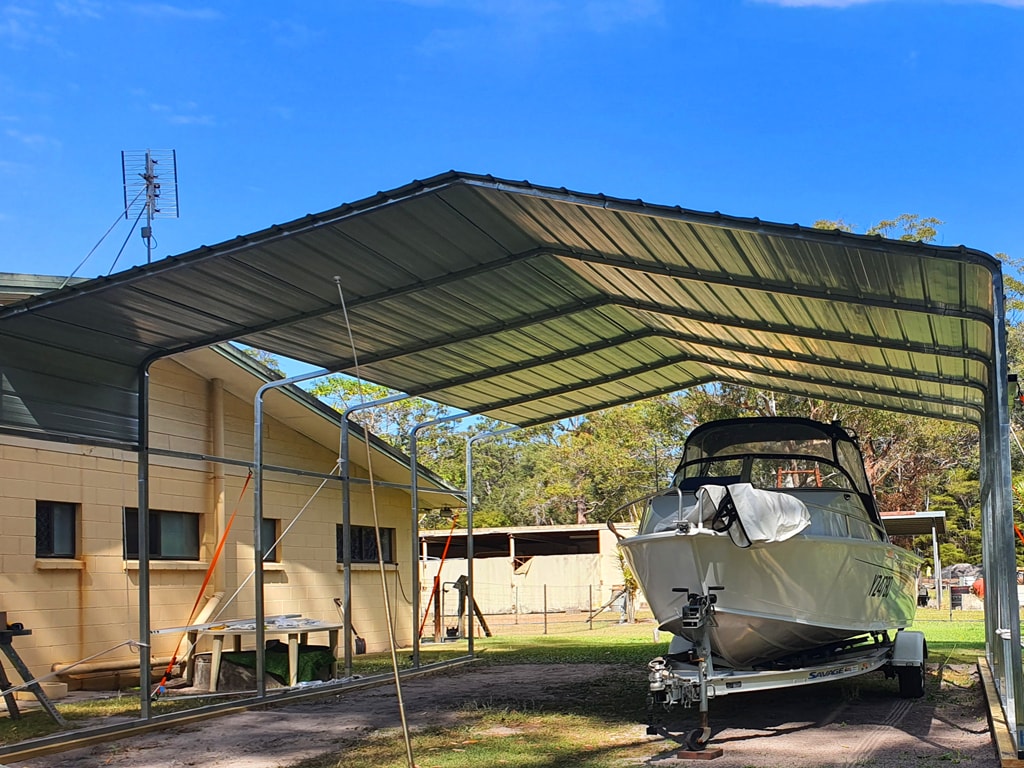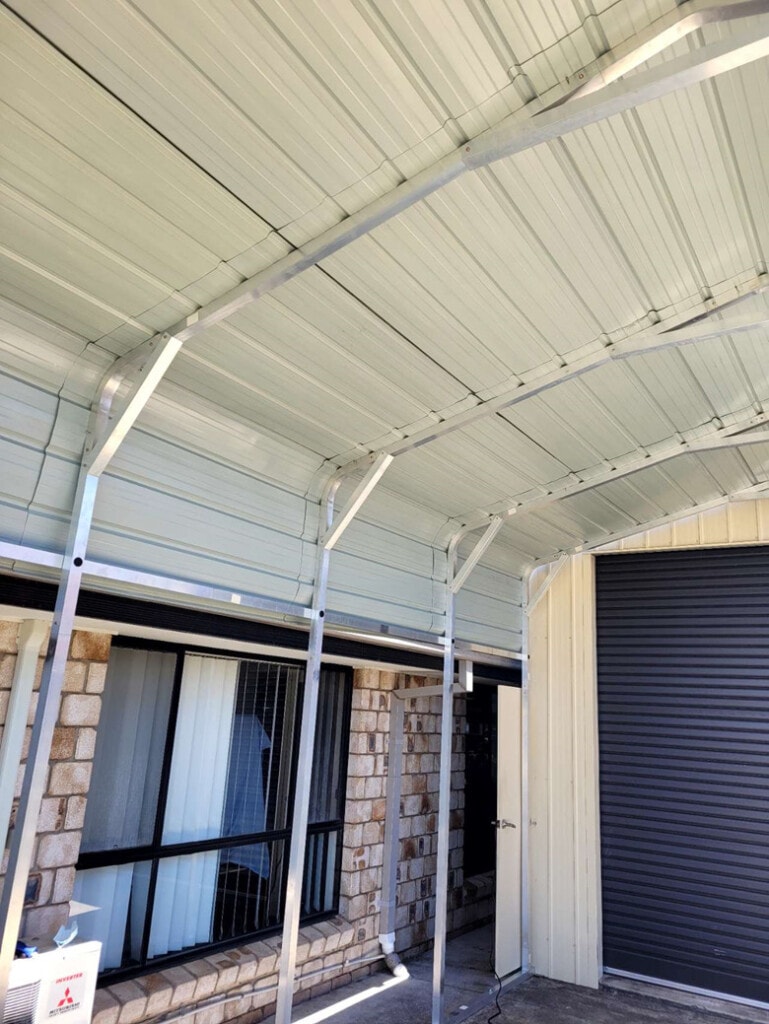Differences Between Metal Carport Roofs: Types and Style

When choosing a roof for a metal building in Australia, whether it’s a garage, shed or barn, you need to choose the type and style of roof. Different metal roofs have their own advantages and considerations, while also taking into account the overall aesthetics of the home.
This guide is designed to help you understand the various roofing options available, explaining their respective advantages and suitability. We’ll also cover some common metal building roof styles to help you choose the best carport for you.
Table of Contents
Types of Metal Carport Roofs
Steel Roofs
Steel roofing offers the highest durability and strength. Steel roof carports are suitable in areas prone to severe weather conditions such as heavy snow or storms. Steel roofs are also particularly resistant to corrosion and pests, giving them a longer lifespan. A common specification for carport steel roofs is 26 gauge panels, which provide a good balance between weight and structural integrity, ensuring a durable covering that can withstand a variety of environmental challenges.
aluminum roof
Aluminum roofing materials stand out for their exceptional resistance to rust and corrosion, making them an ideal choice for coastal areas or regions with high humidity. Thanks to their lightweight yet durable nature, aluminum roofs are simpler to install and demand less structural support compared to heavier alternatives. Typically, carports with aluminum roofs utilize 0.032-inch thick panels, offering a perfect blend of durability and ease of installation. This specification ensures a robust roofing solution that can effortlessly withstand environmental challenges while remaining maintenance-friendly.
galvanized steel roof
Galvanized steel is coated with a layer of zinc for enhanced corrosion resistance, providing a strong and economical roofing solution. This material is ideal for areas with moderate rainfall or industrial settings where extra durability is required. The common gauge for carport galvanized steel roofs is 24, which provides an effective balance between strength and affordability, ensuring the roof is long-lasting and resistant to rust and wear.
Galvalume steel roof
Similar to galvanized steel roofs, galvalume steel roofs are based on steel sheets and are coated with an alloy composed of aluminum, zinc and trace amounts of silicon. The high proportion of aluminum in the coating increases resistance to corrosion, especially corrosion caused by scratches or edge peeling. Galvalume steel roofs are commonly used in variable climates and coastal environments. The surface of a galvanized steel roof has a unique smooth, fine metallic texture that gradually develops into a protective gray-white zinc-aluminum carbonate layer. Typically, a galvanized steel roof costs slightly more than a galvanized steel roof.
Tin roofing
Tin roofing presents a budget-friendly alternative, optimally deployed in regions experiencing gentler weather patterns. While it demands greater upkeep compared to other materials, its cost-efficiency makes tin an attractive option for projects aiming for a vintage aesthetic or operating within limited financial parameters. The usual specification for tin roofs on carports involves employing corrugated sheeting, with a thickness around 0.29 inches. This choice not only assures affordability but also delivers a blend of traditional charm and sufficient durability for milder climates.
Metal Carport Roofing Style
Regular or Standard Roof: The go-to choice for its simplicity and cost-effectiveness, featuring rounded corners and horizontal panels. While it’s great for mild climates, its flat profile might struggle with heavy snow or rain accumulation. It’s like the comfortable, everyday wear of carport roofs – reliable but with limitations in harsh weather.
Boxed-Eave Roof: Sporting an A-frame design that mimics the look of a house, it brings a bit of residential charm to your carport. The horizontal panels are sleek but remember, they’re not the best at handling snow or heavy rain. Think of it as dressing up your carport in business casual; it looks great but isn’t meant for extreme conditions.
Vertical Roof: The all-weather hero, with vertical panels on an A-frame structure for the best water and snow runoff. It’s more expensive but pays off in areas prone to severe weather. This style is like the rugged outdoor gear for your carport, designed to withstand the elements.
Gabled Roof: Features two sloping sides that meet at a ridge, creating a classic and effective design for water runoff. It’s visually appealing and functional, suitable for all climates. It’s the traditional roof style that never goes out of fashion, offering both beauty and performance.
Single Slope or Lean-to Roof: With its singular sloping direction, this design is modern and space-efficient, perfect for tight spaces or as an extension to existing structures. However, its simplicity in drainage design means you’ll want to position it thoughtfully to avoid water pooling. It’s the minimalist chic of carport roofs – sleek, but with a practical twist.
Flat Roof: The epitome of modern design, flat roofs are sleek and understated but require diligent maintenance to avoid water issues. They’re reinforced for water resistance but still, keep an eye out for puddles! This style is like the avant-garde fashion of roofs – forward-thinking and stylish, yet demanding attention to detail.
FAQs
When selecting a material for your metal carport roof, it’s important to balance several key factors:
- Climate: Evaluate your local weather conditions. For example, galvalume is excellent for various climates, especially those with high humidity or fluctuating weather, while galvanized steel is better suited for dryer areas.
- Durability: Consider the lifespan and resilience of the material. While aluminum and galvalume offer superior corrosion resistance, steel might be preferable for its overall strength.
- Maintenance: Reflect on the amount of upkeep you’re willing to commit to. Some materials, like tin, require more frequent maintenance to prevent rust and corrosion.
- Cost: Budget is a crucial factor. More durable materials like galvalume might be pricier upfront but could offer savings in the long term due to their longevity.
Your local climate plays a significant role in deciding the appropriate roof style:
- Heavy Precipitation: Opt for vertical or gabled roofs as they offer excellent water and snow runoff, reducing the likelihood of accumulation and potential damage.
- High Winds: A-frame styles like boxed-eave and vertical roofs provide better wind resistance due to their aerodynamic structure.
- Snow Load: Vertical roofs are ideal for heavy snowfall areas because of their strength and the ability to shed snow efficiently.
Absolutely! Metal carport roofs offer a variety of customization options including different colors, finishes, and styles. This flexibility allows you to match the roof to your existing home or personal taste, ranging from sleek modern finishes to more traditional or rustic looks.
Maintenance varies based on the material:
- Steel and Galvanized Steel: Periodically check for scratches or chips in the paint, which can lead to rust. Regular cleaning and occasional repainting may be necessary.
- Aluminum: Requires the least maintenance due to its rust resistance. Simple cleaning to remove debris and dirt is usually sufficient.
- Tin: Needs regular checks for rust and may require repainting or treating to prevent corrosion.
- Galvalume: Although it’s corrosion-resistant, periodic cleaning and inspection for any damage are recommended.
The lifespan depends on the material:
- Steel and Galvanized Steel: Can last 40-60 years with proper maintenance.
- Aluminum: Has a similar lifespan to steel but with less maintenance.
- Tin: Typically lasts around 30-40 years with regular maintenance.
- Galvalume: Often exceeds 60 years due to its exceptional corrosion resistance.
Safety is paramount during installation. Here are some key considerations:
- Weight Handling: Ensure that the structure can support the weight of the roof. Heavier materials like steel require a sturdier frame.
- Installation Technique: Proper installation is crucial for longevity and safety. Incorrect installation can lead to issues like leaks or structural weakness.
- Weather Conditions: Install the roof during favorable weather conditions. Windy or rainy conditions can make installation hazardous.
- Professional Assistance: For complex installations or if you’re unsure about DIY, it’s wise to consult or hire professionals. They have the expertise to ensure safe and correct installation.
- Protective Gear: Always use appropriate safety equipment like gloves, safety glasses, and hard hats, especially when working at heights.









